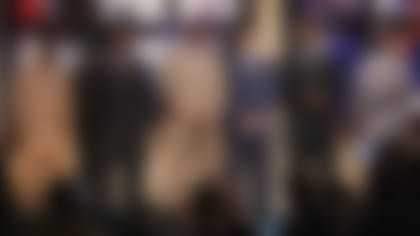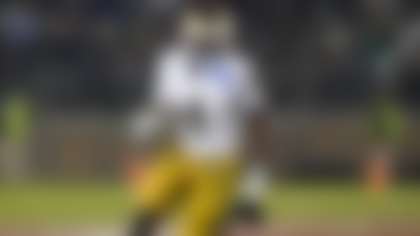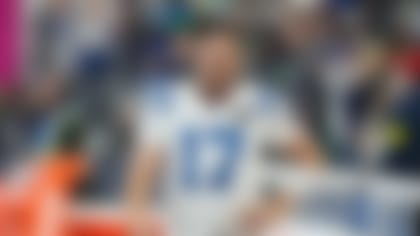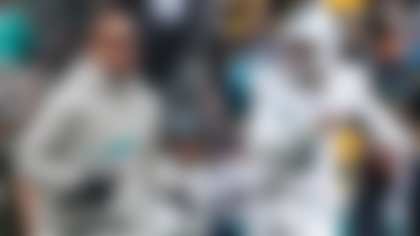D'Brickashaw Ferguson (third from left) hit the Radio City stage before the draft. (Julie Jacobson/AP)
D'Brickashaw Ferguson is an offensive tackle for the New York Jets. With nine professional seasons under his belt, Ferguson will provide occasional insights on life in the NFL. Today, the former first-round pick reminisces on his personal draft experience.
I sat in the green room at Radio City Music Hall for the 2006 NFL Draft. At my table, I was encircled by my parents, brother, agent, former coaches and close friends. We were surrounded by similar scenes at the tables of other top prospects, including Mario Williams, Vince Young, Vernon Davis, Matt Leinart and Reggie Bush. As I nervously waited to hear my name called, my agent continually provided intel on what might happen, yet nothing was certain. I'd visited four teams before the draft, so it was hard to know who was interested in selecting me. As I sat there, all I could do was wait.
Draft night was the culmination of a long pre-draft campaign. Before even getting to that green room, I'd had to complete several stages of the evaluation process. This was my journey to the NFL draft:
Senior Bowl
The Senior Bowl is the top event on the pre-draft all-star circuit. I wanted to know how I stacked up against my peers, so I happily accepted the invitation. Playing on the North Team, we were instructed by the Tennessee Titans' staff, including head coach Jeff Fisher, offensive coordinator Norm Chow and offensive line coach Mike Munchak, a Hall of Fame O-lineman in his own right.
The actual game is only part of the Senior Bowl experience -- the practices are equally important. I tried my best to learn the new offense, but was penalized for jumping offsides during practice, largely due to my unfamiliarity with the quarterbacks (Jay Cutler, Michael Robinson and Charlie Whitehurst). You see, all quarterbacks have different cadences, and only knowing those guys for a day or so, I just didn't have enough time to adjust to each.
The practices were not as long as what I'd typically experienced at the University of Virginia, but the intensity was high -- especially during the one-on-one pass-rush drill. We felt the presence of numerous general managers, head coaches, scouts and front-office personnel watching in the stands. This was a proving ground. And I went up against some talented pass rushers on the North defense -- guys like Tamba Hali, Darryl Tapp, Victor Adeyanju and Mathias Kiwanuka. Kiwanuka, in particular, was someone I wanted to compete against. A sprained MCL had kept me out of our game against Boston College during my senior year, so I was looking forward to going against the two-time All-American in Mobile, Alabama. I knew this was a test that I would need to pass if I hoped to be considered a top offensive lineman. Our one-on-one drill was epic. As he began rushing toward me, I had one thing on my mind: Do NOT let him get to the quarterback. We competed again and again, but I was persistent in not allowing him to achieve his goal. (Our battle, of course, has continued into the NFL, as Mathias has spent the past nine years playing for the New York Giants. If I'm being honest, he has given me trouble on some plays over the years.)
Finally the game arrived, and I had the opportunity to go up against South pass rushers like Elvis Dumervil, Kamerion Wimbley, Manny Lawson and Orien Harris. In the second half, I was going up against Mark Anderson out of Alabama, and I took an improper pass set. He countered my overset with a quick inside move, resulting with a hit on the quarterback. I was disappointed in that play, but I recognized that I was going against the nation's top players. Despite that miscue, overall, I felt confident about what I'd accomplished at the Senior Bowl.
NFL Scouting Combine
Prior to my arrival at the Crowne Plaza in Indianapolis, my agent and I decided that it would be best not to participate in any drills at the combine. We wanted to wait until my pro day at Virginia, where I could limit the distractions and just focus on being my best. Regardless, I was plenty busy in Indy. At the Combine, downtime is rare and sleep is considered a luxury.
Physicals took place first. We all gathered in one of the ballrooms at the hotel, stripped down to our compression shorts and waited to be measured, weighed and visually picked apart by coaches and scouts from every organization. For the weigh-in, we had to get on stage in front of a large room of coaches who were looking at the scale, prominently displayed on an LED screen. When it was my turn to be weighed, I was a little nervous. My weight had been a topic of concern, because I was considered an undersized lineman at 290 pounds in college, and my weight constantly fluctuated. When I stepped on the scale, after gulping down a few Gatorades, I weighed in at 312 pounds. I heard oohs and ahhs throughout the crowd of coaches and thought to myself, Perhaps I overdid it with the Gatorades.
Next on the agenda were the doctor visits. Unlike the typical doctor's appointment, where you see one physician in a private office, at the combine, you meet with several doctors at a time in a giant room. I had pulled an MCL in my senior year, causing me to miss a pair of games, so this was something everyone wanted to take a closer look at. The doctors apparently didn't trust each other -- I had my knee pulled and twisted by four or five different sets of doctors. After hobbling out of my physical examinations, it was time to take some mental ones. In addition to the Wonderlic test, in which I scored an 18, there were an array of other activities. For example, the New York Giants were infamous for their long psychology exams, while the Houston Texans were more focused on testing hand-eye coordination.
During the day, athletes were taken to the RCA Dome to perform the athletic drills we now see on television. Because I decided not to participate, I just followed along with my O-line group and watched at each station. At times, I got pressured to participate by a coach, but I stuck to the plan, smiled and continued along with my group.
In the evenings, it was time for the one-on-one interviews with the individual teams. My agent had advised me to treat this like a business interview and I took that advice to heart. I wanted to make sure their first impression of me would be a lasting one and wore my best suit -- an olive, two-button, notch-lapel getup with a cream-colored shirt and a silk tie. As I walked in the main ballroom past the other players, mostly in T-shirts and shorts, I knew I made the right choice. These meetings were all different and kept you on your toes: some teams wanted me to explain the proper technique necessary for performing a particular block, while others wanted me to talk about my interests.
I was happy when the combine was over -- I did what I'd come to do, and then it was time to prepare for my pro day.
Pro day
Since I'd decided against performing drills at the combine, this was a huge day for me. My strength coach, Evan Marcus, was responsible for leading the proceedings. And after retaking my height and weight measurements in the weight room, we proceeded to the bench press. I had spent a lot of time on the bench at Tom Shaw's Performance Training Camp in Orlando, and one important factor was controlling your breathing. As I got set up at the bench on my pro day, I took one deep breath and began to press, only releasing a small breath with each rep. As I started to fatigue, I began to inhale and exhale with each repetition. I finished with 26 repetitions, a number I felt good about. A short time later, I posted a 30-inch vertical jump, and then we transitioned into the indoor facility for the remainder of the evaluation.
As we began to stretch, I couldn't help but see the scouts busy taking notes. First came the 40-yard dash. After warming up and taking a couple practice runs, it was time for the real thing. I walked up to the line, got on one knee -- this position is known as "taking a picture" -- placed my hand slightly behind the start line and rose into my final position. I tried my best to jump out of my shoes, throw my hand forward and sprint as fast as I could. My time: 5.08 seconds. Then I performed the short shuttle (4.89 seconds), three-cone drill (7.64) and broad jump (8-foot-11). After doing the best I could in those events, I got ready for my O-line positional drills.
In this part of the session, I had to perform run-blocking and pass-blocking techniques. In one drill, we utilized a blocking pad and perform a drive block. In another, we incoporated a kick slide -- a technique used in pass protection to get to a defender -- and then attacked the bag with both hands.
After the day was over, I was both physically and mentally drained. It was over and all I could do was wait. I had done everything I was asked to do -- now it was up to the general managers and coaches to decide my fate.
Draft night
The first player to leave the green room on draft night: Mario Williams, who was taken No. 1 overall by the Houston Texans. Through much of the pre-draft process, many people believed Reggie Bush would be the first player selected. He ended up going second, to the New Orleans Saints. Vince Young was taken third by the Tennessee Titans.
And then it happened.
I received a call from Jets general manager Mike Tannenbaum and head coach Eric Mangini. They asked me if I was ready to become a New York Jet. I quickly answered yes and began to hug everyone at the table.
As I made my way to the stage, I was handed a New York Jets hat, which I proudly put on. Then I walked across the stage and shook Commissioner Paul Tagliabue's hand.




